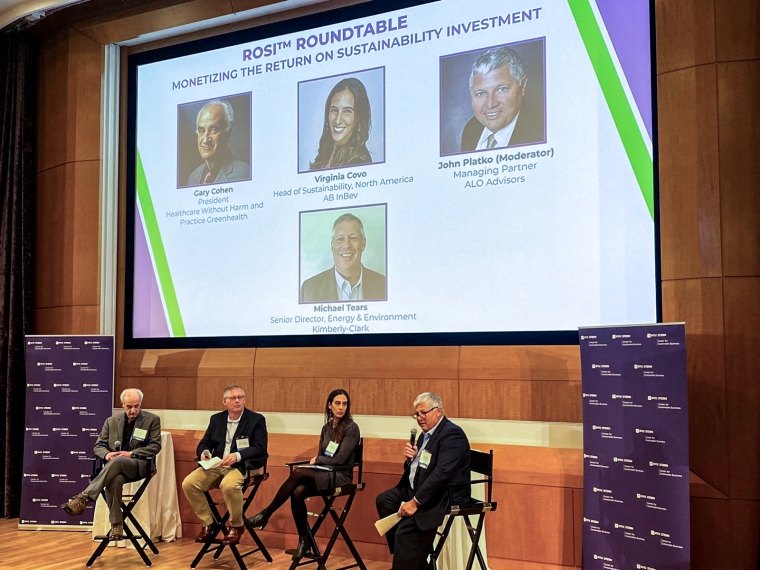Business resilience is more important than ever. As we’ve all experienced in the years since 2020, unprecedented shifts in society and the economy can result in long-term ripple effects that defy a “return to normal.” True business resilience is surviving and thriving in the “new normal” by having the ability to respond and adapt to unexpected changes while preparing for the ever-evolving global business landscape.
Sustainability is synonymous with business resilience, especially when it’s truly embedded into an organization’s business practices. Sustainability is “embedded” when an organization fully integrates environmental, social, and related resilience considerations into its core business strategies, governance, planning, and operational processes, treating these considerations as integral to financial and operational decision-making.
In other words, an organization that embeds sustainability is better prepared to move forward on the right initiatives (targeting the most significant risks that are addressable) in the right way (leveraging existing business processes instead of reinventing the wheel) to take meaningful action, thereby strengthening its ability to thrive through foreseen and unforeseen future challenges.
INTEGRATING SUSTAINABILITY FOR ENHANCED BUSINESS RESILIENCE
Embedding sustainability into your organization means strengthening the accountability of sustainability and resilience within existing teams, departments, and processes rather than dedicating more resources and assigning sole accountability to a stand-alone sustainability team. It’s a proactive approach to business resilience; one that yields results from an outcomes, cost, and investment perspective.
Create meaningful outcomes:
- Recognize efficiencies by leveraging the collective input and intellect of the organization in identifying and effectively managing material sustainability and resilience risks/opportunities (e.g. leaders perceive sustainability risks and opportunities as business risks and opportunities).
- Pursue these challenges the same way other important business topics are addressed, by leveraging existing management processes, practices, and routines that are familiar to company leaders and their teams.
- Create highly relevant and achievable objectives, goals, and performance indicators that leaders understand and regularly use to assess progress and make informed decisions on critical environmental, social, and resilience issues.
- Establish “roadmaps” for action, charting tangible efforts and investments required to achieve objectives and goals established by an organization’s leaders.
Realize cost efficiencies and returns on investment:
Embedding sustainability is about building local capabilities and re-allocating duties versus adding new processes, teams, or departments to an organization. Investment in educating cross-functional teams about business connections to sustainability and resiliency will yield measurable returns on investment. Once implemented, work and accountabilities for making the business more sustainable will reside with relevant existing operations and functions. Higher costs are avoided by proactively leveraging the collective intellect and capabilities of the organization (the eyes, ears, and minds closest to the action), reducing the financial impact of reactivity and minimizing the unpredictability of when these unpleasant surprises may arise.
 2023 Practice Forum where John Platko (right) moderated a panel with ROSI/Monetization clients in New York.
2023 Practice Forum where John Platko (right) moderated a panel with ROSI/Monetization clients in New York.
5 STEPS TO EMBED SUSTAINABILITY INTO YOUR ORGANIZATION
So, how can a business embed sustainability into its organization? Drawing from our experience supporting clients across industries with sustainability strategies and risk assessments, we’ve simplified the process to five steps.
Step 1: Assess Readiness
Integrating sustainability into the core of a business requires a profound mindset shift across the organization. The focus is on strengthening the knowledge and approach to sustainability within existing teams, departments, and processes — not revamping but rather enhancing current business operations to better align with business resilience ambitions. This endeavor is most effective when a company has already cultivated a mature sustainability agenda, and the overall environment is ripe for such an innovative approach.
Executive support for embedded sustainability is critical for success. The organization needs a well-defined decision-making structure and strong governance framework to handle sustainability-related risks and opportunities, like any other business risks and opportunities. Begin by calibrating the level of awareness and concern from senior leaders across the organization about the business ramifications of key sustainability and resilience issues. Evaluate how current risk management, financial planning, and decision-making processes can integrate principles of sustainability.
Step 2: Onboard Leaders
Executive, functional, and operational leadership support is essential to successfully embed sustainability. Once you’ve established readiness, the second step focuses on building leadership’s understanding of the merits of this approach and promoting a broader organizational “buy-in.”
Onboarding leaders to this concept entails conveying a cohesive narrative that explains why, what, and how a more integrated approach will benefit business sustainability and resilience. Specific expectations for leaders and clear, actionable plans to get started are also communicated. This is an iterative process that typically involves a series of workshop sessions with different levels of cross-functional leadership that will be directly involved in the transformation.
Step 3: Build Consensus & Momentum
Once leaders are onboarded, it’s time to build consensus on the path forward. Step 3 begins by gathering perspectives from functional and operational leaders to identify the organization’s most material sustainability and resilience challenges. This information is then organized into a collection of priority topics and associated shared objectives that apply to all functions and departments. These shared objectives outline the problems to be solved and define a collective vision of success that can be achieved through collaboration on formulated lines of action and associated initiatives.
This step establishes a framework for the organization’s approach to embedded sustainability with governance of shared objectives at the leadership level and implementation driven at the operational or departmental level. This approach leverages every department’s unique method to managing risks, investing in initiatives, or driving execution of solutions already in flux for a priority topic. For example, let’s say a shared objective is to improve employee retention by 15% YOY. The Human Resources department may already have initiatives in play that contribute to this shared objective.
Step 4: Identify & Bridge the Gaps
With an embedded sustainability framework in hand, now it’s time to model, monetize, and make the business case for collective investments in sustainability and resilience. Leadership and subject matter experts (SMEs) use business models to identify gaps between ongoing efforts and what’s needed to avoid the consequences of inaction for each shared objective. By monetizing the magnitude of these gaps (learn more about the Return on Sustainability Investment), the organization can define additional initiatives, evaluate investments, and integrate solutions into existing business planning and execution processes.
The organization’s leaders receive tangible details on the consequences of inaction and the resources needed (additional investment, time, and talent) to drive business sustainability and resilience, leading to more informed and improved decision making.
Step 5: Formalize the Transformation
The initial experience of managing sustainability and resilience in an integrated, business-centric way in the first four steps prepares leaders to fully adopt the embedded approach. Businesses formalize the transformation when leaders across the organization are proactively addressing challenges more holistically with sustainability and resilience in mind.
As this transformation occurs, accountability for managing and driving initiatives to address sustainability-related risks and opportunities is methodically shifted to the business functions and operations nearest to these issues. The sustainability department evolves into an advisory role, focused on capability-building and enabling and ensuring progress.
DRIVING EFFECTIVE ACTION THROUGH EMBEDDED SUSTAINABILITY
After going through these five steps to embed sustainability, organizations are prepared to address environmental and social “curveballs” — there is an organic shift from reactive responses to proactive, long-term solutions. Organizations can drive sustainability-related actions more effectively with collective buy-in and support from across the company, using the existing infrastructure that is designed to enable business resilience.
SWCA’s Sustainability and Management Consulting team helps clients manage sustainability-related risks and opportunities in ways that create business value while also making positive environmental and social impacts. Our team is committed to helping each client with a successful sustainability journey. Whether at the starting line, well into strategy development, or building a business case for more sustainability decisions, SWCA can help with where to start, where to focus, and where to invest for the best sustainability solutions.
MEET THE EXPERTS

Laura Nelson, Principal Sustainability Team Lead
With nearly 20 years of experience in the environmental and sustainability services field, Laura has provided strategic sustainability solutions to clients in the food and beverage, consumer goods, manufacturing, technology, finance, and energy industries. She specializes in sustainability disclosure frameworks and standards. View bio.

John Platko, Vice President of Sustainability and Management Consulting
John has more than 35 years of business, sustainability, and environmental, health, and safety (EHS) leadership experience. He develops and executes strategies that prioritize the creation of business, environmental, and social value for a diverse range of clients, including multinational companies in the food, beverage, consumer product, energy and manufacturing sectors. View bio.
